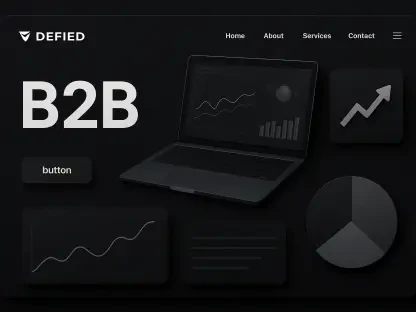In the fast-paced world of digital marketing, SEO continues to be a cornerstone for businesses aiming to secure a strong online presence. In 2025, the integration of AI technologies into SEO practices has revolutionized how search engines operate, presenting both challenges and opportunities. This article explores the essential strategies and key statistics to help businesses navigate the AI-driven SEO landscape.
The Evolving SEO Landscape
The landscape of SEO is constantly shifting, with AI playing an increasingly pivotal role. Recent years have seen the introduction of AI Overviews and Large Language Models (LLMs), significantly impacting user interactions with search engines. Understanding these developments is crucial for staying competitive. AI has transformed the way search engines deliver results, providing users with immediate answers to their queries and reducing the need for them to scroll through multiple search results. This shift has increased the complexity and competitiveness of the SEO landscape.
With 57% of marketers reporting a rise in SEO competition due to AI advancements, businesses must adapt their strategies to maintain and improve their search rankings. The traditional approach to SEO, which primarily focused on keyword optimization and backlinks, is no longer sufficient. Now, a more nuanced understanding of user intent and sophisticated content strategies is essential for success. By leveraging AI-driven insights, businesses can tailor their SEO efforts to better meet user expectations and enhance their online visibility.
Google’s Dominance in the Search Market
Google’s dominance in the search engine market is unparalleled, with an 89.79% global market share. This overwhelming lead positions Google as the primary focus for any SEO strategy. By contrast, competitors such as Bing hold only a 3.93% market share, with Yandex and Yahoo following at 2.73% and 1.27%, respectively. This dominance underscores the critical importance of optimizing for Google to capture the majority of search traffic.
In the realm of mobile search, Google’s supremacy is even more pronounced, commanding a staggering 93.82% of the global market. The sheer volume of traffic and revenue generated by Google further emphasizes its pivotal role in digital marketing. In 2024, Google generated $348.16 billion in revenue, marking a $43 billion increase from the previous year. This growth highlights the significant impact of mobile search on overall traffic and the necessity for businesses to prioritize mobile optimization in their SEO strategies.
Additionally, Google facilitated around 85.5 billion visits in March 2024, with substantial search traffic coming from countries like India, where Google accounted for 90.81% of desktop searches, and South Korea, with 86.72%. These statistics illustrate the global reach and influence of Google’s search engine, making it imperative for businesses to align their SEO efforts with Google’s algorithms and best practices to maximize their online presence.
Shifts in User Behavior and Search Trends
User behavior has adapted to the changes brought by AI advancements, necessitating businesses to remain agile in their SEO strategies. Approximately 50% of users now click on a result within 9 seconds of conducting a search, emphasizing the need for top-ranking positions to capture user attention quickly. The average click occurs in just 14.6 seconds, highlighting the importance of swift and engaging content that meets user queries promptly.
Moreover, user engagement metrics reveal that 59% of users visit only one page per search session, and merely 9% reach the bottom of the first page. These habits underscore the necessity of securing prominent positions in search results to ensure visibility and drive click-through rates (CTR). Exceptional content and effective use of meta descriptions and title tags are crucial for optimizing CTR and increasing traffic.
The distribution of clicks also highlights the significance of top-ranking positions, as the first search result garners nearly 27.6% of all clicks. Consequently, securing a top spot not only boosts visibility but also enhances user trust and engagement. Businesses must continually refine their SEO strategies to maintain high rankings and adapt to evolving search trends. By leveraging AI-driven insights and focusing on creating valuable, relevant content, businesses can better meet user expectations and drive sustained organic growth.
The Importance of Intent-Driven Strategies
The advent of AI in SEO has shifted the focus from simple keyword optimization to a deeper understanding of user intent. This transformation is reflected in the evolving strategies adopted by marketers to achieve better engagement and ROI. The importance of intent-driven strategies has grown significantly, with 49% of marketers reporting the best return on investment (ROI) from organic search. This finding underscores the critical role of understanding user intent in driving successful SEO outcomes.
Conversion rates provide further insights into the effectiveness of intent-driven strategies. eCommerce websites, for instance, generally achieve a conversion rate between 2% and 5%. Specific industries, such as food and beverage, exhibit even higher rates, with conversion rates reaching 4.9%, while the electronics sector maintains a 3.6% rate. These statistics highlight the value of targeted, intent-based SEO strategies in driving higher engagement and conversions.
Budget allocation also reflects the growing emphasis on SEO. More than half of SEO professionals allocate between $500 and $5,000 to their SEO efforts, with a significant 28.6% spending between $1,000 and $5,000. This investment demonstrates the recognition of SEO’s critical role in achieving business goals and driving organic growth. By focusing on user intent and leveraging AI technologies, businesses can refine their SEO strategies to better align with user needs and enhance their overall digital marketing efforts.
Content Marketing ROI
Content marketing has always played a vital role in SEO, but its importance has only grown with the integration of AI. When combined with SEO, content marketing yields impressive returns on investment (ROI). Basic content marketing alone offers a 16% ROI, demonstrating its value in driving engagement and visibility. However, the addition of thought leadership content can elevate this ROI to a staggering 748%, showcasing the synergistic potential of integrating various content strategies.
Technical SEO also contributes significantly to content marketing ROI, achieving a 117% return. This highlights the importance of optimizing content for search engines while ensuring it meets user intent and expectations. By investing in high-quality, value-driven content and leveraging advanced SEO techniques, businesses can maximize their returns and enhance their online presence.
Creating compelling content that resonates with target audiences requires a deep understanding of user needs and preferences. By utilizing AI-driven insights, businesses can tailor their content to address the specific pain points and interests of their audience, increasing engagement and driving conversions. This approach not only improves content marketing ROI but also strengthens the overall impact of SEO strategies.
Securing Positions and Featured Snippets
The prominence of AI Overviews and rich snippets in search engine results has shifted the focus towards securing top positions and featured snippets. These elements play a crucial role in driving visibility and engagement, with the first search result achieving a nearly 27.6% click-through rate (CTR). Featured snippets, which provide concise, direct answers to user queries, capture 35.1% of clicks, further emphasizing their importance in SEO strategies.
The impact of moving up in search rankings is also significant, with a single spot improvement resulting in a 2.8% increase in CTR. This competitive advantage highlights the need for businesses to prioritize their search rankings and optimize their content for featured snippets. Consistency across devices is equally important, as 79% of search engine results pages (SERPs) show the same featured snippets on both mobile and desktop.
To secure top positions and featured snippets, businesses must focus on creating high-quality, relevant content that addresses user queries effectively. Utilizing structured data and schema markup can enhance the visibility of content in search results and improve the chances of being featured in rich snippets. By staying ahead of the competition and continuously refining their SEO strategies, businesses can capitalize on the benefits of top-ranking positions and featured snippets.
The Evolving Role of Keywords
The role of keywords in SEO has evolved significantly, moving from simple optimization components to symbols of user intent. With the advent of AI, the focus has shifted towards creating content that aligns with user search queries and delivers meaningful answers. Long-tail, conversational keywords have become increasingly important for appearing in featured snippets and voice search results.
Approximately 8% of search queries now include question phrases such as “how,” “what,” and “why.” These queries signal intent and require content that provides detailed, informative answers. Keywords that are 10 to 15 words long receive 1.76 times more clicks than shorter ones, emphasizing the importance of detailed, intent-based searches.
By focusing on user intent and incorporating long-tail keywords into their content, businesses can improve their search rankings and drive organic traffic. Understanding the evolving role of keywords and leveraging AI-driven insights can help businesses create content that resonates with their target audience and meets their needs. This approach not only enhances the effectiveness of SEO strategies but also strengthens overall digital marketing efforts.
The Power of Backlinks
Backlinks remain a powerful signal to search engines, suggesting the content’s value and trustworthiness. They continue to be a vital factor in SEO, with 92.3% of top 100 search results having at least one backlink. This underscores the importance of building a strong backlink profile to enhance search engine rankings and drive organic traffic.
The number of domains linking to a site shows the highest correlation with its ranking position. A diverse and authoritative backlink profile indicates the credibility and relevance of the content, positively influencing search engine algorithms. Additionally, long-form content tends to attract more backlinks, receiving 77.2% more links than shorter pieces. This highlights the value of creating comprehensive, in-depth content that provides valuable information to users.
To build an effective backlink profile, businesses must focus on creating high-quality content that others find valuable and worth linking to. Engaging in outreach campaigns, collaborating with industry influencers, and leveraging social media platforms can help in acquiring authoritative backlinks. By prioritizing the development of a robust backlink profile, businesses can enhance their SEO efforts and improve their search engine rankings.
Technical SEO Elements
Technical SEO is as crucial as content and backlinks in achieving SEO success. Key technical elements such as site speed, mobile optimization, and page title management play a vital role in improving search engine rankings and user experience. Ensuring that these technical aspects are optimized is essential for maintaining a competitive edge in the AI-driven SEO landscape.
One significant aspect of technical SEO is the optimization of page titles. Google changes 61% of all page title tags based on length and keyword usage, highlighting the importance of crafting precise and compelling titles. Titles that accurately reflect the content and include relevant keywords can significantly improve click-through rates (CTR) and overall visibility.
Another important element of technical SEO is the use of anchor texts. Content with exact match anchor texts sees five times more traffic, emphasizing the need for precise and relevant anchor text strategies. Additionally, building a single backlink takes 1 to 5 hours for many SEO professionals, indicating the time investment required to develop a strong backlink profile.
Structured data and schema markup also play a crucial role in technical SEO. The use of structured data, such as Open Graph and JSON-LD, can enhance content visibility in search results and improve the chances of being featured in rich snippets. By prioritizing technical SEO elements and leveraging advanced optimization techniques, businesses can enhance their search engine rankings and drive organic traffic.
Local SEO and “Near Me” Searches
Local SEO has become increasingly important in the age of AI, as proximity-based searches and “near me” queries have risen significantly. Businesses need to optimize for local search to capture this growing segment of users. Key statistics underscore this trend, with 76% of users who search “near me” visiting a business within 24 hours. This behavior highlights the immediate impact of local searches on driving foot traffic and conversions.
Local searches also have a high potential for purchases, with around 20% resulting in a purchase within a day. This statistic emphasizes the importance of optimizing for local search to drive immediate sales and increase revenue. Consumers consider a business 2.7 times more reputable if it has a complete Google Business Profile, underlining the importance of maintaining up-to-date and accurate business information online.
To effectively leverage local SEO, businesses should focus on optimizing their Google My Business profiles, ensuring accurate location and contact details, and generating positive customer reviews. Additionally, incorporating local keywords and creating localized content can enhance visibility in local search results. By prioritizing local SEO efforts, businesses can capture the attention of nearby customers and drive real-world interactions.
Mobile SEO Optimization
Mobile search has become the dominant mode of internet usage, making mobile SEO a fundamental aspect of any SEO strategy. Google’s dominance in mobile search is evident, handling 95% of mobile searches in the US. This statistic underscores the necessity for businesses to optimize their websites for mobile devices to capture the majority of mobile search traffic.
Mobile eCommerce is also on the rise, with 70% of online shoppers using smartphones to make purchases. This trend highlights the importance of mobile-optimized eCommerce websites to facilitate seamless user experiences and drive sales. Moreover, Google Lens, a visual search tool, is used to answer about 8 billion questions per month, demonstrating the growing influence of visual search in the mobile ecosystem.
To optimize for mobile SEO, businesses should focus on creating responsive website designs, ensuring fast loading times, and implementing mobile-friendly navigation. Additionally, optimizing images and utilizing schema markup can enhance the user experience and improve search engine rankings. By prioritizing mobile SEO, businesses can cater to the growing number of mobile users and maintain a competitive edge in the digital marketplace.
Voice Search Impact
The rise of voice search is profoundly influencing the way users interact with technology and access information. As more people use voice-activated assistants for their searches, businesses must adapt their SEO strategies to ensure they remain visible and relevant in this evolving landscape. Voice search queries tend to be longer and more conversational than traditional text searches, which means that content must be optimized to match this natural language pattern. Additionally, local businesses can benefit significantly by ensuring that their information is accurate and up-to-date in local listings since voice searches often have a strong local intent. As voice search technology continues to improve, its impact on consumer behavior and digital marketing strategies will only become more pronounced.
Voice search has seen a significant increase, and businesses need to adapt their content strategies to accommodate this trend. Nearly 50% of US consumers use voice search daily, reflecting its growing importance in the digital landscape. As voice search queries are typically longer and more conversational, optimizing content for these types of searches is crucial.
Approximately 40.7% of voice search answers originate from featured snippets, highlighting the importance of securing these positions to capture voice search traffic. The average voice search query contains 29 words, indicating the need for detailed and informative content that addresses user queries effectively. This shift towards longer, conversational keywords requires businesses to focus on creating content that aligns with natural language patterns and user intent.
To optimize for voice search, businesses should incorporate question-based keywords, utilize structured data, and focus on creating concise, direct answers to user queries. By adapting to the rise of voice search and aligning content strategies with user behavior, businesses can improve their chances of appearing in voice search results and enhance their overall SEO efforts.
Video SEO Insights
Video content has become a vital component of digital marketing, necessitating specific SEO strategies to maximize its effectiveness. With 89% of businesses using video SEO and 95% of marketers considering video as crucial, the importance of optimizing video content for search engines is clear. Video SEO not only enhances visibility but also drives engagement and conversions, making it a valuable addition to any SEO strategy.
The optimal length for marketing videos is under 10 minutes, with 1-3 minutes considered the sweet spot for engagement. This length ensures that videos capture and retain user attention, increasing the likelihood of shares and interactions. Moreover, video content has a comparable conversion rate to other content types, emphasizing its effectiveness in driving sales and achieving marketing goals.
To maximize the impact of video SEO, businesses should focus on creating high-quality, engaging video content that resonates with their target audience. Utilizing relevant keywords in video titles, descriptions, and tags can enhance visibility in search results. Additionally, incorporating transcripts and closed captions can improve accessibility and further optimize videos for SEO. By prioritizing video SEO, businesses can leverage the power of video content to enhance their digital marketing efforts and achieve better results.
B2B and Enterprise SEO Focus
B2B SEO presents unique challenges, including longer sales cycles and the involvement of multiple decision-makers. Despite these challenges, B2B SEO remains a critical component of digital marketing strategies. Approximately 66% of B2B consumers use online search to explore potential purchases, highlighting the importance of SEO in influencing purchase decisions and driving business growth.
B2B companies recognize the value of SEO, with 49% employing it in their marketing strategies. This reliance on SEO underscores its effectiveness in reaching target audiences and generating leads. Furthermore, B2B businesses allocate around 15% of their marketing budget to SEO, demonstrating their commitment to leveraging SEO for achieving marketing goals and driving organic growth.
To address the unique challenges of B2B SEO, businesses should focus on creating valuable, informative content that addresses the specific needs and pain points of their target audience. Utilizing long-tail keywords and optimizing for intent-based searches can enhance visibility and engagement. Additionally, leveraging AI-driven insights can help B2B companies refine their SEO strategies and achieve better results in a competitive landscape.
eCommerce SEO Statistics
For eCommerce businesses, SEO is critical due to its reliance on online traffic for driving sales and revenue. Certain categories, such as apparel and shoes, lead online purchases, with 67.1% and 44% of purchases, respectively, being made online. This trend underscores the importance of optimizing eCommerce websites for search engines to capture the growing number of online buyers.
Conversion rates further highlight the significance of eCommerce SEO, with desktops achieving higher conversion rates (3%) compared to mobile devices (2%). This statistic emphasizes the need for eCommerce businesses to optimize for both desktop and mobile users to maximize conversions and enhance the overall shopping experience.
Effective eCommerce SEO strategies include optimizing product descriptions, utilizing high-quality images, and implementing structured data to enhance visibility in search results. Prioritizing site speed and mobile optimization can also improve user experience and drive higher conversion rates. By focusing on these key aspects, eCommerce businesses can enhance their SEO efforts and achieve better performance in the competitive digital marketplace.
AI and SEO Integration
The integration of AI in SEO has led to notable changes, improving content creation efficiency, predictive analytics, and overall performance. Despite its benefits, 72% of SEO professionals still do not use AI in their strategies. However, those who do recognize its positive impact, with 83% acknowledging the improvements AI has brought to their SEO efforts.
AI has significantly enhanced workflow speed, with 52% of marketers reporting that AI has improved their efficiency. By automating routine tasks, AI allows SEO professionals to focus on more strategic initiatives and creative content development. This increased efficiency translates to better performance and more effective SEO strategies.
To fully leverage the benefits of AI, businesses should consider incorporating AI-driven tools and technologies into their SEO practices. These tools can provide valuable insights into user behavior, content performance, and optimization opportunities, helping businesses refine their strategies and achieve better results. By embracing AI, businesses can stay ahead in the competitive SEO landscape and enhance their overall digital marketing efforts.
Future-Ready SEO Strategy
In the rapidly evolving realm of digital marketing, SEO remains a vital component for businesses aiming to establish and sustain a robust online presence. As we near 2025, the infusion of AI technologies into SEO practices has transformed how search engines function, creating both challenges and new opportunities. This article delves into fundamental strategies and crucial statistics designed to assist businesses in maneuvering through the AI-powered SEO environment.
AI technologies, such as machine learning and natural language processing, have significantly impacted various SEO tactics. Search engines are becoming increasingly adept at understanding user intent, analyzing web content, and delivering highly personalized search results. Businesses must now focus on creating quality content that is both relevant and engaging to meet these advanced algorithms’ criteria.
Furthermore, AI-driven tools and software are paving the way for more precise and efficient keyword research, backlinking strategies, and competitive analysis. Staying ahead in AI-driven SEO means continuously adapting to new trends and technologies while monitoring performance metrics closely. Understanding and leveraging these advancements enables businesses to enhance their visibility and drive organic traffic effectively. By doing so, they ensure their success in a competitive digital landscape.









